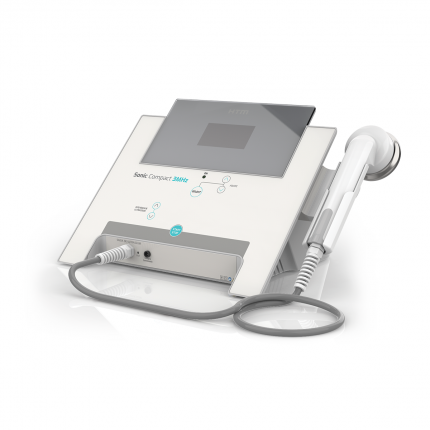Description Sonic Compact 3 MHz
Sonic Compact 3-MHz ultrasound device
The SONIC COMPACT 3 MHZ is a portable ultrasound device with 3.0 MHz frequency. With continuous emission and 30 options of pulsed, it covers all esthetic treatments through the micromassage. Also offers treatment protocols to assist the applications.
Visualização 360°
Accessories Included
• DVD Instruction manual
• Transducer
• Head support
• Power Cord
• Cable for combined therapy
Protocols
TREATMENT SUGGESTION
Cellulitis Protocol
1) Exfoliate the whole region to be worked with exfoliating gel and remove it.
2) Apply green clay mask throughout region and leave it for approximately 20 minutes, then remove it.
3) Perform lymphatic drainage.
4) Apply conductive gel with lipolytic active principles in the entire region of treatment.
5) Select the FEG protocol in the equipment, in accordance with the degree of cellulitis. Choose the options FEG I and II or FEG III.
6) Perform circular and slow movements with the applicator across the region of treatment.
7) Remove all the gel.
8) Apply cryotherapic gel in the region to be worked on and do not take bath until 3 hours after application.
Liposuction Postoperative protocol
1) Sanitize the region of treatment with cleansing gel
2) Spray restoring fluid with active ingredients such as aminoacids and trace elements.
3) Apply conductive gel with active principles throughout the region of treatment.
4) Select the protocol POST-LIPO in equipment.
5) Perform circular and slow movements with the applicator in regions submitted to liposuction.
6) Remove all the gel.
7) finalize with Manual Lymphatic Drainage.
Frequent Questions
1. What is Phonophoresis?
It consists in the use of ultrasound waves to administer substances through the skin. The Phonophoresis has the capacity to introduce medicines independent of electrical charge, because it is a mechanical process that increases the permeability of the membranes, allowing the absorption of substances.
2. What is the frequency of ultrasound?
It has a frequency of 3Mhz.
3. May the ultrasound be used after mesotherapy to spread enzymes?
No, the ultrasound denatures enzymes, reducing its action in 73% within 15 minutes of application, therefore, the claim that the ultrasound spreads enzymes injected doesn’t have any foundation.
4. What would be the best gel for ultrasound use?
The ideal gel to work with any type of ultrasound should be devoid of bubbles, with clear and transparent aspect, odorless and without the presence of additives (alcohol, essences, etc.). The optimal amount of gel is one that allows the head to slide freely, without adhering to the patient’s skin.
5. Can the gel be used from one area to another?
It is not advisable, because usually after its use in a region there is the formation of microbubbles, and its appearance becomes turbid, which indicates a poor conduction.
6. Why does the movements of ultrasound should be slow and continuous?
Due to the lack of uniformity of the ultrasound beam, the head should not be stopped on the same place. It must not be moved very fast, because there would be no time for the tissue to enter into resonance. The best procedure is the circular dislocated motion at a speed of 1 to 2 cm/second.
7. What is cavitation?
To radiate ultrasound in liquid leads to the formation of very small bubbles, and this phenomenon is called cavitation. Under the action of the ultrasonic field, these bubbles increase and decrease in size (Stable cavitation), or may collapse (unstable cavitation). Cavitation is a common phenomenon produced by therapeutic ultrasound.
8. What is the size of the ERA of equipment?
It features 7cm2 ERA.
9. What is the combined therapy of Sonic Compact?
It is the simultaneous application of two stimulus, in this case, the ultrasound with electrical stimulation, by combining the effects of currents with the effects of ultrasound.
10. How does the combined therapy of Sonic Compact works?
To use the combined therapy of Sonic Compact is required the use of an electro stimulator (Equipment of currents of electrostimulation).
The unique cable that comes with the product must be connected to the output for combined therapy in Sonic Compact and its other end with alligator claw, it must be connected to the output of the application cable of your current equipment.
On the other wire of the application cable of the same channel, the electrode must be connected to and fixed near the region of treatment. This way, the current will close the field between the head of the ultrasound and the electrode.
11. Why is the combined therapy of Sonic Compact a benefit?
The combined therapy of Sonic Compact allows the junction of two therapeutic modalities being applied simultaneously.
This way, the effects of one therapy on the other are amplified, bringing better therapeutic results.
12. What equipment may be associated with the combined therapy of Sonic Compact?
Any electrical equipment (stimulator of currents of electrostimulation) can be used in conjunction with the Sonic Compact.
Among the equipment of HTM line we can mention: Stimulus Face, Endstria, Stimulus-R, Stimulus Physio, Clinical and Portable Tens Fes.
13. With which currents the combined therapy of Sonic Compact can be used?
The combined therapy can be used by associating the ultrasound excitomotor currents of medium frequency, as the Russian current, for example, in addition to the polarized currents as the Micro current and Galvanic current.
14. What is the difference between the combined therapy of Vibria and Sonic Compact?
The difference lies in the question of how the current is distributed in the tissue, i.e., with the Vibria and its three transducers, the current closes field between each transducer.
This way, the current migrates from one transducer to another. The Sonic Compact, as it features a single transducer, needs an external electrode to close the current field.
In addition, a current equipment is needed for the technique.

